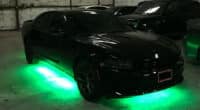If you’re planning to install underglow lights on your car, the first thing you should know is that there are laws surrounding this upgrade.
This is mainly to avoid letting these lights distract other vehicles for safety reasons.
So, you should know that there are state-wise laws that tell you what the limits are. These laws are sometimes different for LED underglow lights and neon underglow lights.
If you’re in Nevada, you will be bound by the Nevada Vehicle Code. In this article, we’ll tell you everything that you need to know before installing this upgrade.
Nevada Laws for Underglow Lights

The state code is where you will find relevant information about underglow lighting in the state of Nevada.
We recommend keeping an eye on the Nevada Revised Statutes and check Title 43 which is titled “Public Safety, Vehicles, Watercraft”. Under that, Chapter 484 which is titled “Traffic Laws, Equipment of Vehicles, Lamps and Other Equipment for Lighting” contains updated information about this law.
In the state of Nevada, underglow lighting is legal. There are no specifications related to neon lighting, which leads to the reasonable assumption that they are legal as well. However, there are some rules you need to adhere to so that you don’t get into trouble:
- Light Type: Your lights cannot be flashing, especially if they’re amber colored, because that profile is reserved for warning lights. You can do this only when there is a traffic hazard that’s applicable to everyone on the road.
- But you can use amber lights for turn signals as usual. You’re also not allowed to mount flashing amber lights permanently if you don’t have a permit issued by the Nevada Highway Patrol.
- Size: There is no specification on underglow light sizes, neon or LED.
- Permitted Colors: Any light visible from the front of the car should be amber in color and lights visible from the back should be red. The lights on the license plate can only be white. It is recommended to avoid red, blue and green underglow lights because they’re used by emergency vehicles.
An exception for red color on the rear includes stoplights and signal lights which can be yellow, amber or red. The license plate must be illuminated in white color. If there’s a backup lamp, it must be amber or white.
And if you’re on a motorcycle, the tail lamp should have a blue insert that isn’t more than 1 inch in diameter. Here are some other specifics according to 486.261 of the Nevada Revised Statutes.
- The motorcycle should have a minimum of 1 tail lamp on the rear, which should be visible from 500 feet behind the vehicle.
- The motorcycle tail lamp should also light up whenever the headlamp does.
- It should meet all the requirements of size, color and intensity mentioned in this piece.
Are Underglow Neon Lights Legal In Nevada?

Yes, they have a few restrictions. The underglow lights, neon or not, when seen from the front, should be amber and the lights visible from the back should be red. The lights on the license plate should be white and none of the lights should flash or rotate.
State of Nevada Info

Located in the western region of the country, Nevada is the 36th state in the United States. It is the seventh largest in terms of land area.
Though it is mostly an arid state, the mountains are dotted with about 15% of forests.
The state’s economy rides on mining and the tourism industry. Legalized gambling in the state is a big tourist attraction. It ranks fourth in gold production around the world.
The metropolitan city of Las Vegas is the state’s economic center and its biggest city. Of the 16 counties, Clark County is Nevada’s most populous county.
Population: 2,758,931
Capital: Carson City
Registered vehicles: 1,361,671
Total lane miles: 100,805
Number of highways: 6
Nevada Lighting Law References:

